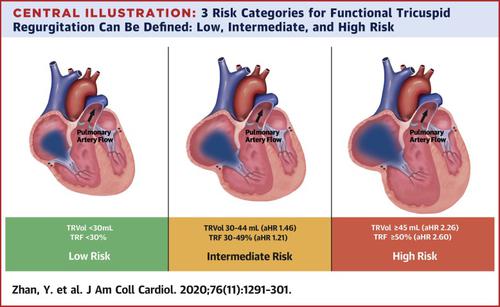当前位置:
X-MOL 学术
›
J. Am. Coll. Cardiol.
›
论文详情
Our official English website, www.x-mol.net, welcomes your
feedback! (Note: you will need to create a separate account there.)
Natural History of Functional Tricuspid Regurgitation Quantified by Cardiovascular Magnetic Resonance
Journal of the American College of Cardiology ( IF 21.7 ) Pub Date : 2020-09-01 , DOI: 10.1016/j.jacc.2020.07.036 Yang Zhan 1 , Dany Debs 2 , Mohammad A Khan 2 , Duc T Nguyen 3 , Edward A Graviss 4 , Shaden Khalaf 2 , Stephen H Little 2 , Michael J Reardon 2 , Sherif Nagueh 2 , Miguel A Quiñones 2 , Neal Kleiman 2 , William A Zoghbi 2 , Dipan J Shah 2
Journal of the American College of Cardiology ( IF 21.7 ) Pub Date : 2020-09-01 , DOI: 10.1016/j.jacc.2020.07.036 Yang Zhan 1 , Dany Debs 2 , Mohammad A Khan 2 , Duc T Nguyen 3 , Edward A Graviss 4 , Shaden Khalaf 2 , Stephen H Little 2 , Michael J Reardon 2 , Sherif Nagueh 2 , Miguel A Quiñones 2 , Neal Kleiman 2 , William A Zoghbi 2 , Dipan J Shah 2
Affiliation

|
BACKGROUND
Quantitation of tricuspid regurgitant (TR) severity can be challenging with conventional echocardiographic imaging and may be better evaluated using cardiovascular magnetic resonance (CMR). OBJECTIVES
In patients with functional TR, this study sought to examine the relationship between TR volume (TRVol) and TR fraction (TRF) with all-cause mortality. METHODS
We examined 547 patients with functional TR using CMR to quantify TRVol and TRF. The primary outcome was all-cause mortality. Thresholds for mild, moderate, and severe TR were derived based on natural history outcome data. RESULTS
During a median follow-up of 2.6 years (interquartile range: 1.7 to 3.3 years), there were 93 deaths, with an estimated 5-year survival of 79% (95% confidence interval [CI]: 73% to 83%). After adjustment of clinical and imaging variables, including RV function, both TRF (adjusted hazard ratio [AHR] per 10% increment: 1.26; 95% CI: 1.10 to 1.45; p = 0.001) and TRVol (AHR per 10-ml increment: 1.15; 95% CI: 1.04 to 1.26; p = 0.004) were associated with mortality. Patients in the highest-risk strata of TRVol ≥45 ml or TRF ≥50% had the worst prognosis (AHR: 2.26; 95% CI: 1.36 to 3.76; p = 0.002 for TRVol and AHR: 2.60; 95% CI: 1.45 to 4.66; p = 0.001 for TRF). CONCLUSIONS
This is the first study to use CMR to assess independent prognostic implications of functional TR. Both TRF and TRVol were associated with increased mortality after adjustment for clinical and imaging covariates, including right ventricular ejection fraction. A TRVol of ≥45 ml or TRF of ≥50% identified patients in the highest-risk strata for mortality. These CMR thresholds should be used for patient selection in future trials to determine if tricuspid valve intervention improves outcomes in this high-risk group.
中文翻译:

通过心血管磁共振量化功能性三尖瓣反流的自然史
背景 三尖瓣反流 (TR) 严重程度的定量可能对传统的超声心动图成像具有挑战性,并且可以使用心血管磁共振 (CMR) 进行更好的评估。目的 在功能性 TR 患者中,本研究试图检查 TR 体积 (TRVol) 和 TR 分数 (TRF) 与全因死亡率之间的关系。方法 我们使用 CMR 对 547 名功能性 TR 患者进行了检查,以量化 TRVol 和 TRF。主要结果是全因死亡率。轻度、中度和重度 TR 的阈值是根据自然史结果数据得出的。结果 在中位随访 2.6 年(四分位距:1.7 至 3.3 年)期间,有 93 人死亡,估计 5 年生存率为 79%(95% 置信区间 [CI]:73% 至 83%) . 调整临床和影像学变量后,包括 RV 功能,TRF(每 10% 增量调整后的风险比 [AHR]:1.26;95% CI:1.10 至 1.45;p = 0.001)和 TRVol(AHR 每 10-ml 增量:1.15;95% CI:1.04 至1.26;p = 0.004)与死亡率相关。TRVol ≥ 45 ml 或 TRF ≥ 50% 的最高风险分层中的患者预后最差(AHR:2.26;95% CI:1.36 至 3.76;TRVol 和 AHR:2.60;95% CI:1.45 至 3.76;p = 0.002 4.66;TRF 的 p = 0.001)。结论 这是第一项使用 CMR 评估功能性 TR 的独立预后影响的研究。在调整临床和影像协变量(包括右心室射血分数)后,TRF 和 TRVol 均与死亡率增加有关。TRVol ≥ 45 ml 或 TRF ≥ 50% 确定患者处于死亡风险最高的层次。
更新日期:2020-09-01
中文翻译:

通过心血管磁共振量化功能性三尖瓣反流的自然史
背景 三尖瓣反流 (TR) 严重程度的定量可能对传统的超声心动图成像具有挑战性,并且可以使用心血管磁共振 (CMR) 进行更好的评估。目的 在功能性 TR 患者中,本研究试图检查 TR 体积 (TRVol) 和 TR 分数 (TRF) 与全因死亡率之间的关系。方法 我们使用 CMR 对 547 名功能性 TR 患者进行了检查,以量化 TRVol 和 TRF。主要结果是全因死亡率。轻度、中度和重度 TR 的阈值是根据自然史结果数据得出的。结果 在中位随访 2.6 年(四分位距:1.7 至 3.3 年)期间,有 93 人死亡,估计 5 年生存率为 79%(95% 置信区间 [CI]:73% 至 83%) . 调整临床和影像学变量后,包括 RV 功能,TRF(每 10% 增量调整后的风险比 [AHR]:1.26;95% CI:1.10 至 1.45;p = 0.001)和 TRVol(AHR 每 10-ml 增量:1.15;95% CI:1.04 至1.26;p = 0.004)与死亡率相关。TRVol ≥ 45 ml 或 TRF ≥ 50% 的最高风险分层中的患者预后最差(AHR:2.26;95% CI:1.36 至 3.76;TRVol 和 AHR:2.60;95% CI:1.45 至 3.76;p = 0.002 4.66;TRF 的 p = 0.001)。结论 这是第一项使用 CMR 评估功能性 TR 的独立预后影响的研究。在调整临床和影像协变量(包括右心室射血分数)后,TRF 和 TRVol 均与死亡率增加有关。TRVol ≥ 45 ml 或 TRF ≥ 50% 确定患者处于死亡风险最高的层次。











































 京公网安备 11010802027423号
京公网安备 11010802027423号